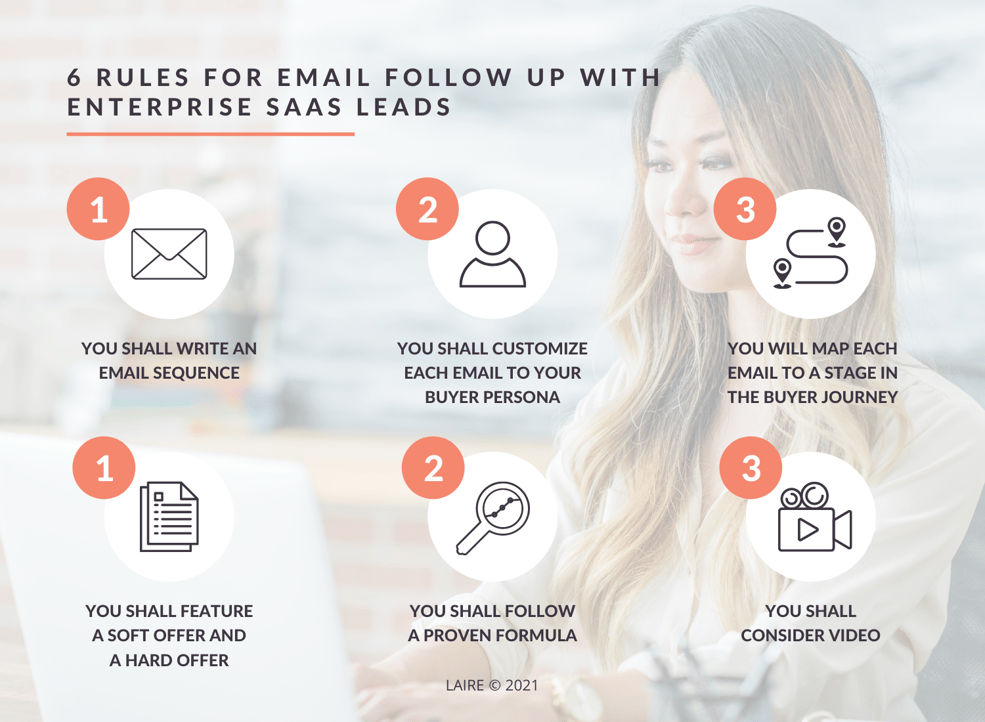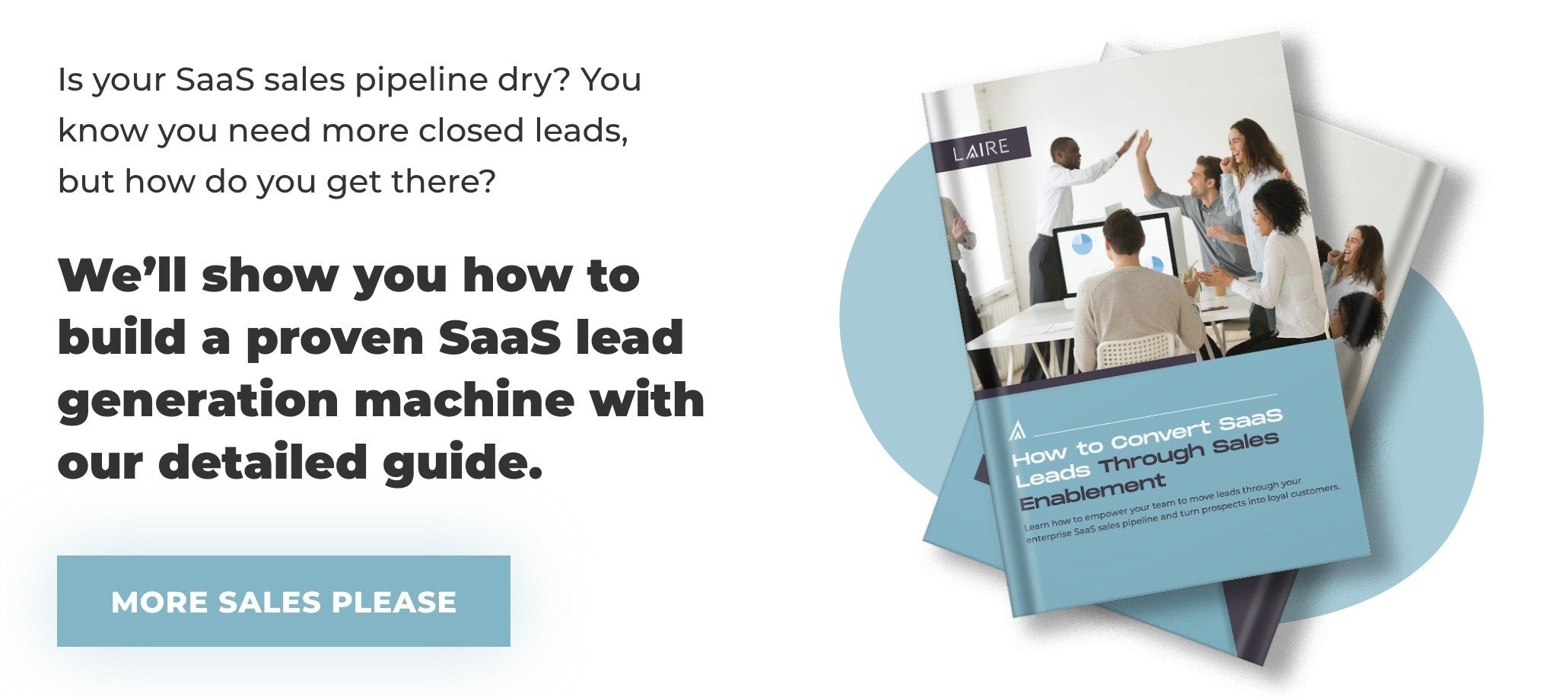If you want to succeed at enterprise SaaS sales, you must master effective email follow up. Let’s parse that for a minute.
First, you must follow up. More deals are lost to lack of follow up than to any other factor. Second, you must follow up by email. Your prospects live in their email inboxes, and so email must be the main channel you use to follow up with them. Third, your follow up must be effective. Your goal isn’t just to add leads to a drip email sequence. Your goal is to craft a sequence of emails that move leads down your pipeline towards a sales conversation or a sale.
What this means in practical terms is that, if you want to be successful at enterprise SaaS sales, you must learn how to write effective email sequences. Here are the six rules you must follow to get you there.
Rule 1: You Shall Write an Email Sequence
Enterprise SaaS follow up is all about anticipating the needs and problems and challenges of your potential customers, and then addressing them, one at a time, as your buyer moves along their buyer journey. This means follow up is never about writing one email, but is always about writing a series of emails, a series that follows a logical sequence and cadence.
An email sequence is a series of messages sent to a prospective customer with the goal of moving that person along their buyer journey. These sequences typically consist of an introductory message, a series of follow-up messages, and a final message.
The first email introduces the sender to the recipient. The follow-up sequence features individual emails that offer something of value and encourage the reader to take an action. And the final email is the final kick at the can of persuading the recipient to take the desired action.
The goal of enterprise SaaS follow-up email sequences is lead nurturing, or lead cultivation. Your goal is never to make a sale. Your goal is always to get the prospect to take the next action in the buying process or sales cycle. This requires that you write a series of emails.
Rule 2: You Shall Customize Each Email to Your Buyer Persona
In enterprise SaaS email follow up, there isn’t really any such thing as an “email template” as sales reps understand that term. There is no one-size-fits-all email that you can confidently send to every lead at every stage of their buyer journey.
The quickest way to land in the trash folder is to send generic, impersonal messages. The quickest way to get opened and read is to send emails that are customized for your reader. You do this by personalizing each email to the needs, challenges, pain points and goals of a particular buyer persona on the buying committee.
The clumsy way to customize emails is to insert the prospects name or company name liberally throughout the email. But this requires no knowledge of your buyer, and buyers see through it as insincere, since it is.
The better way to customize your emails is to speak to the needs and challenges that you know your prospect is facing, based on your discovery call, follow-up phone calls, reviewing of their company LinkedIn page, news events about the company, happenings in their industry, and so on.
Rule 3: You Will Map Each Email to a Stage in the Buyer Journey
If you want prospects to open and read your emails, you must craft messages that are both timely and relevant. In other words, your emails must say the right thing at the right time.
For example, if your buyers are at the start of your pipeline, your emails should focus on educating them about the problem your product or service solves. If they are further along your pipeline, at the consideration stage, for example, your emails should provide information and resources that help your buyers solve their business challenges. If your buyers are at the vendor-selection stage, your emails must provide content that helps them evaluate vendors make a wise decision. And if your buyers are at the decision stage, your sequence should focus on moving buyers to choose your solution.
Each email you write in your follow-up sequence requires context and continuity. With each email you craft, aim to demonstrate how it is a logical follow-up message based on your most recent interaction with the prospect, whether that interaction was by phone, Zoom call, email or in person. Remind the prospect why you are writing. Refer to an action they took, or to your last email. Prove that you have a connection with the reader, and that you have a timely and relevant reason for writing.
Rule 4: You Shall Feature a Soft Offer and a Hard Offer
If your results are typical, the majority of prospects who receive your follow-up emails do not want to talk with a salesperson. Sad, but true. What they do want from you is information that educates them, challenges them and helps them make a buying decision, or a decision that moves them to the next stage in their buyer journey.
This means your emails must meet your prospects where they are. They likely need information from you. But they also may want to speak with you. Which means each email you write must include a soft offer and a hard offer.
A softer offer is an offer of a white paper, buying guide, case study or other asset that the prospect gets without speaking to anyone in sales. You typically make this offer in the form of a link that the prospect clicks to download the asset.
A hard offer is an offer that involves speaking with someone in sales. It offers a free consultation, or a free, in-person assessment, or a guided product demo. The call to action is to pick up the phone and call you, or to click a link to schedule a meeting.
As you can imagine, soft offers are more popular with buyers than hard offers. Most prospects still prefer to walk through the store without the help of a sales rep. But some prospects are ready to talk with you. And so, you must get the most value from every email in your sequence by including one soft offer and one hard offer.
Rule 5: You Shall Follow a Proven Formula
Most enterprise SaaS sellers are better selling in person than they are selling by email. They prefer talking to typing. And their preference is evidenced by the vast number of badly written, poorly structured emails that are sent to prospects each day.
To improve the quality and effectiveness of your emails, follow these industry best practices.
- Write a subject line that teases. Your only goal with your subject line is to get your prospect to open and read your email. So, keep it short, and write something that makes your message irresistible.
- Address your prospect by name: In enterprise SaaS sales, there is no such person as “Sir or Madam.” And we have yet to meet “To whom it may concern.” And the same goes for the lame, “Hi there.” Always start your email by addressing your reader by name.
- Demonstrate relevance immediately: Your enemy is the next email in the inbox. And the phone on your prospect’s desk. So, start your email with a startling fact, a clever quote, a remarkable statistic from Gartner—anything to grab your prospect’s attention and prove that you have something timely and relevant to share.
- Name a new pain point: Your email is part of a sequence, so share the next-most-logical customer challenge or pain point that your solution solves.
- Agitate: Describe in a simple sentence the consequences your prospect faces by not eliminating their pain or meeting their challenge.
- Present your solution: Again, in one sentence if possible, explain how your SaaS product solves your buyer’s challenge.
- Offer something new and helpful: Offer something of value, whether that’s a blog post, white paper, special report or case study (your soft offer). But also offer something helpful that is also more immediate, such as a guided demo or consultation (your hard offer).
- Ask for the order: Your goal with enterprise SaaS follow-up emails is never to close a deal, but it is always to drive action. So, always ask for the order. Invite your prospect to download something, or click a link, or dial a number. As Wayne Gretzky puts it, “You miss 100% of the shots that you never take.”
Rule 6: You Shall Consider Video
Frank Weschler is a Sales Development Rep at Dynamic Signal, a SaaS firm that helps enterprise clients modernize employee communications. When he was assigned Buffalo Wild Wings as a target account, Frank knew he needed to do something special to break through the noise. So, he hopped in his car and drove to his nearest Buffalo Wild Wings restaurant. He bought the hottest item on their menu and took it back to the office. Made from ghost peppers, Blazin’ Wings measure in at 350,000 units on the Scoville scale.
Frank sat down at his desk in front of his webcam, and hit the red record button. He then took a bite, and delivered his pitch. Through laughter, tears, and near-choking, he introduced his company and their enterprise SaaS solution, and asked for a meeting. He booked the meeting.
Check out the video to discover why video should be part of your email follow-up sequences.
Conclusion
As you can appreciate by now, follow-up email sequences are designed to move leads down the buyer journey towards a decision. Each email in the sequence educates, offers something of value, and asks the recipient to take the next in the buying process.
The beauty of email sequences is that they help you scale your pipeline. When these emails are automated, they go out to your prospective buyers while you are busy doing other things. This is one of the major benefits of email sequences—they ensure that you follow up on all of your leads, even when you are preoccupied or busy. The secret to success in enterprise SaaS sales is follow-up, after all, persistent (but pleasant) follow-up.
This blog is part of a six-part sales enablement series. Please find links to the remainder of the series below:
Chapter 1: Seven Unique Challenges Facing Enterprise SaaS Sales Teams
Chapter 2: Six Keys to Effective Sales Enablement for Enterprise SaaS Sales Teams
Chapter 3: Why (and How) Follow-Up is the Key to Enterprise SaaS Sales Success
Chapter 4: Eight Steps for Effective Follow-Up with Enterprise SaaS Leads
Chapter 5: Six Rules for Email Follow-Up with Enterprise SaaS Leads
Chapter 6: Five Ways to Create Sales Enablement Content that Moves Leads Along Your SaaS Pipeline



